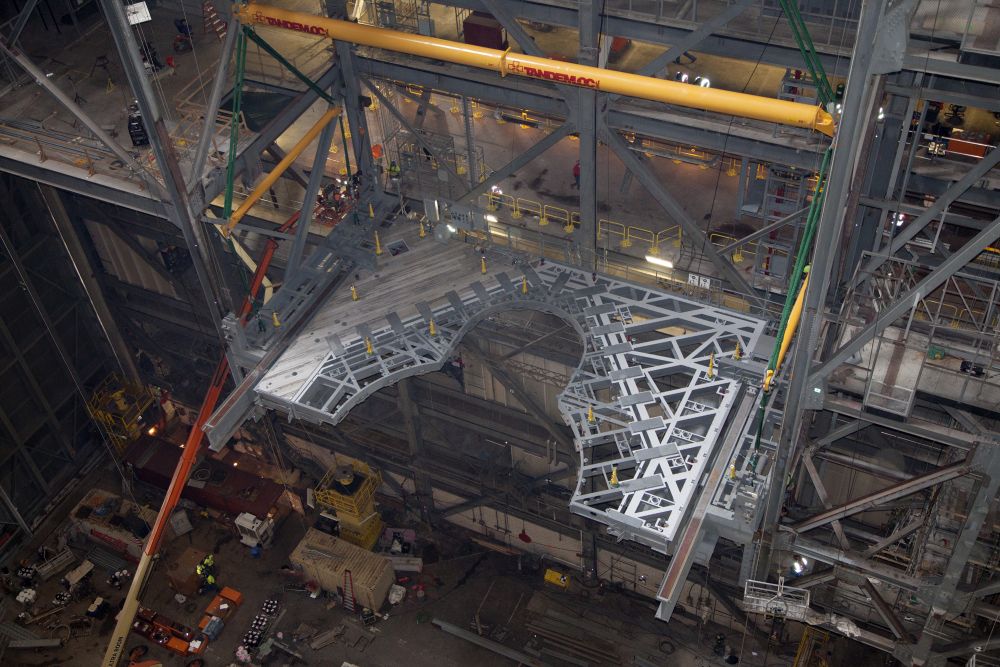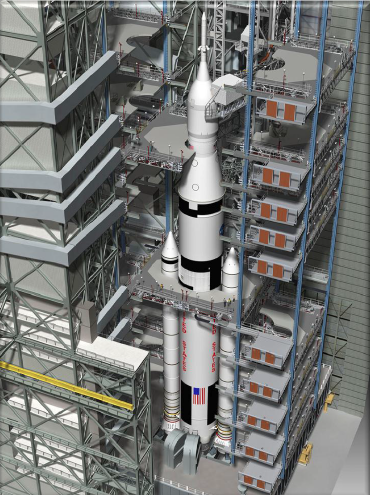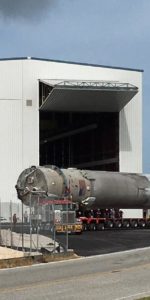
It’s the mammoth building that has captured the imaginations of visitors, space fans, and space workers alike: NASA Kennedy’s iconic Vehicle Assembly Building (VAB). It’s the building that housed the Apollo era’s mighty Moon-bound Saturn-V rockets, and for over 30 years it was where space shuttle stacks were put together. While it’s the same building of the Apollo and shuttle days, still dwarfing anything else on the landscape of Florida’s “Space Coast,” a new program has it fast entering the future.
As NASA enters 2016, the VAB continues to transition from the shuttle program era to the Space Launch System (SLS) era, undergoing numerous upgrades and modifications for Exploration Mission-1 (EM-1)—the first shakedown mission of the “Block I” SLS launch vehicle integrated with the Orion spacecraft, European Space Agency-built service module, and twin Orbital ATK solid rocket boosters. In 2013, all space shuttle work platforms in High Bay 3 were removed to make way for a new platform system that is designed to support processing of the SLS and Orion, as well as other exploration vehicles.

On Dec. 23 the VAB’s High Bay-3 (the future “home” of the SLS) received its K-level work platform, the first of 10 to be installed prior to EM-1 vehicle processing in the VAB.
Using an overhead crane, capable of lifting up to 325 tons, the piece was inserted “through an opening in the divider between the bays approximately 19 stories up, across the transfer aisle, and then lowered … into High Bay 3.” The space agency emphasized, at a later time, these same cranes will pick up heavy rocket pieces and will be putting them precisely into place.
“This is a very exciting time for NASA and Kennedy Space Center as we prepare the VAB for the SLS rocket,” said Edsel Sanchez, PE, the Ground Systems Development and Operations Program VAB Site Project manager. “It’s an honor to make history and be part of the team that is working hard to bring NASA’s vision to fruition.”
Twenty platform halves will be installed for a total of 10 work platforms; the A level platform will be 346 feet (approximately 35 stories) above the VAB floor. The K level platform is approximately 86 feet (nine stories) up and will allow workers to have access to the SLS core stage and segmented solid rocket boosters during processing and stacking operations on the mobile launch platform. Mechanical, electrical, and plumbing systems will be prepared in High Bay 4, to be transferred to the “home of the SLS,” High Bay 3.
“The giant steel platforms, each measuring 38 feet long and 62 feet wide, will be attached to rail beams that will provide structural support and contain the drive mechanisms to move them in and out or up and down as needed,” says NASA.
NASA Kennedy’s Ground Systems Development and Operations (GSDO) Program and associated contractors have been busy modifying the VAB and adjacent sites as EM-1 approaches, scheduled to launch in late 2018. The VAB has also been undergoing upgrades to low-voltage power sources in High Bay 3 and repairs and upgrades to vertical-lift doors. In addition, some ground and support equipment has been investigated for signs of degradation and corrosion.
In August, NASA announced that GSDO had achieved a major milestone with the award of a Ground Support Equipment Installation Contract, meant to aid in preparing a new mobile launcher for SLS operations. Modifications have been made to Firing Rooms 1 and 4, the Multi-Payload Processing Facility (MPPF), and the Launch Equipment Test Facility (LETF). The LETF’s aft skirt electrical umbilicals, which will provide power and data to the SLS until liftoff, were tested and verified to be working this year.
Launch Pad 39B also has a completely different look; gone is the appearance of a “shuttle pad.” In August, NASA stated: “A clean pad concept has replaced the configuration once used for space shuttle launches. The pad’s surface has been completely upgraded. New crawler track panels have been installed and concrete repairs have been completed. The flame trench walls have been resurfaced and work soon will begin on a new flame deflector that will support launch of the SLS rocket.” Pad 39B was last used for the shuttle program during the STS-116 launch on Dec. 9, 2006, and was last used for the Ares I-X launch on Oct. 28, 2009.
Extensive upgrades also extend to the vehicle responsible for bringing SLS from the VAB down a gravel track to the launch pad. This is where modifications to the diesel-electric Crawler Transporter-2 (CT-2) come into play. While CT-1 will be used for launch vehicles such as SpaceX’s Falcons set to launch at Pad 39A, CT-2 will be used to move the SLS (at a very slow rate of speed) to Pad 39B. However, during the shuttle years, the crawlers moved a total of 12 million pounds to the pad. For SLS, the crawler will need to carry an unprecedented 18 million pounds. Notably, the crawlers also turned 50 this year. Two previous AmericaSpace articles published in February and March discussed the extensive upgrades that have been made to CT-2 to allow the vehicle to upgrade its lifting capacity.
On the SLS front, in October NASA announced that a Critical Design Review had been completed, as well as a separate review by a Standing Review Board. SLS is on-track for its first test flight, EM-1, in late 2018, with human-helmed flights to take place no later than 2023. EM-1 will see the Block I configuration SLS launch an Orion capsule, integrated with a European Space Agency-built service module (which owes a lot of its hardware heritage to its Automated Transfer Vehicle or ATV, which carried cargo to the International Space Station through 2014). The Orion capsule will make a circumlunar flight; this will be the first mission utilizing a human-rated capsule leaving Earth’s orbit since December 1972’s Apollo 17.
This year also saw an SLS’s solid rocket booster “Qualification Motor” undergo a successful test firing at Orbital ATK’s northern Utah test site, while the seventh test firing of Aerojet Rocketdyne’s SLS RS-25 development engine—the same type of engine used to power the shuttles—went off without a hitch in August at Stennis Space Center in southern Mississippi. Two boosters and four RS-25 engines will power the SLS off the launch pad and into space from Florida, and tests for both will continue into 2016.
In addition, a new orange paint scheme was revealed for the launch vehicle, hearkening back to the days of the space shuttle.
While NASA continues to develop its next beyond-Earth orbit launch vehicle, its flagship building continues to be modified to meet its needs. And in 2018, SLS will roll out of the VAB, carried by CT-2, for the first time.
.
Be sure to “Like” AmericaSpace on Facebook and follow us on Twitter: @AmericaSpace
.
Missions » SLS » Missions » SLS » EM-1 »





Great
How can CT-1 be used for SpaceX if their horizontal integration facility was built on the crawler way before pad 39A?
It’s a beautiful weldment. Looking forward to the first pictures of the SLS (full scale pathfinder I assume) in the VAB.
Interesting article about the crawler transporters. But, SpaceX built it’s own transporter erector for the F-9 vehicles due to blast off from LC-39A. Unless SpaceX’s transporter erector is now called CT-1.
No problem. Move SpaceX’s building and transporter erector elsewhere.
Launchpad 39A ‘belongs to’ NASA’s SLS Moon rocket, not a private company’s ‘politically gamed’ monopoly launcher.
The President needs to quit favoring one California space company in the foolish hope of harvesting California campaign contributions and Democratic Party votes for the next hundred years. California is important, but so is the rest of the country and our laws.
Maybe the President, and NASA’s leaders, should read and fully implement the human Lunar surface mission ‘National Aeronautics and Space Administration Authorization Act of 2010 (PUBLIC LAW 111-267 OCT. 11, 2010)’ which he signed into law. Are we a nation of laws or simply folks who ‘bow down’ to accept the President’s chosen ‘political winners’ and ‘losers’?
“The Orion capsule will make a circumlunar flight; this will be the first mission utilizing a human-rated capsule leaving Earth’s orbit since December 1972’s Apollo 17.”
Other folks are making plans to get to the Moon.
‘Russia’s Big Plan To Finally Put Cosmonauts on the Moon Making sense of the latest shakeup at Roscosmos’ by Anatoly Zak January 6, 2016.
At: http://www.popularmechanics.com/space/moon-mars/a18849/russia-plan-cosmonauts-moon/